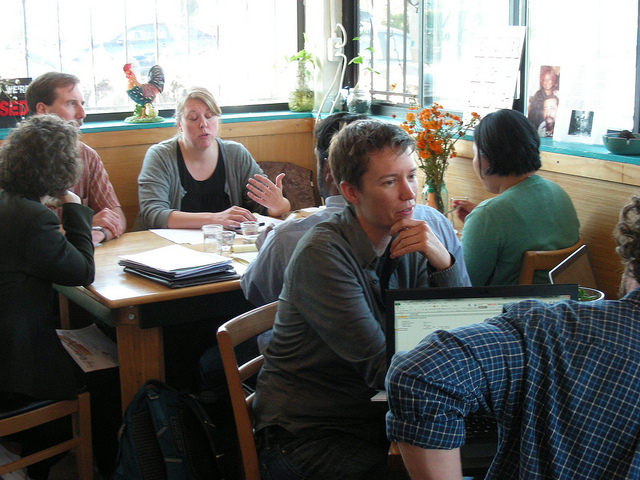New York City is full of cafes that people use as workspaces. In the Chelsea area where I have been staying for the past week, here is one every few blocks. Inside is a familiar sight: people intensely concentrate on their phones or computer screens, often with earplug wires framing their faces, books and papers scattered around, a drink. A pleasant silence fills the room.
Lately, I noticed that the social function of these cafes is expanding. They seem to serve as community centers. It is 7PM on a weekday in Pushcart Coffee on Ninth Avenue and West 25th Street. To my right, an attractive youthful woman is practicing her halting French with an equally attractive French-native young man. To my left, two women are taking a lesson in weaving. The instructor and each student have set up portable looms on the big table. Next to them two women are knitting in deep concentration, occasionally exchanging tips. Further out, in a corner, six young men sit on stools in a circle, conducting an intense discussion in very soft voices.
 The interior design of the café, and others like it in this neighborhood, invites these activities. There is a very large table in the center, a work bench of sorts, made of rough uneven wood full of kinks, cuts, and grooves, as though used for decades to make things, and large enough to accommodate more than a dozen people. Electrical outlets line the floor. More traditional café tables fill the periphery of the room. The sound absorbing materials and soft overhead lights create a relaxing atmosphere while panoramic windows open up to the New York streetscape. People speak in quiet tones, so different from the noise of the city’s restaurants.
The interior design of the café, and others like it in this neighborhood, invites these activities. There is a very large table in the center, a work bench of sorts, made of rough uneven wood full of kinks, cuts, and grooves, as though used for decades to make things, and large enough to accommodate more than a dozen people. Electrical outlets line the floor. More traditional café tables fill the periphery of the room. The sound absorbing materials and soft overhead lights create a relaxing atmosphere while panoramic windows open up to the New York streetscape. People speak in quiet tones, so different from the noise of the city’s restaurants.
Most people in these WiFi cafes are young. These are the millennials. Why do they hang out here, for hours at a time? These are not dating places: too quiet and too little conversation for that. I am sure that some are trying to get away from cramped city apartments and annoying roommates. But it seems to me that something else, more significant, is at work here: they like doing their own thing while being surrounded by other people like themselves. They like being part of a community.
This is sustainable consumption: the patrons of these cafe-community centers are not shopping, not watching television, are not exposed to advertising, are consuming very little. When I think about their future I find it hard to imagine that they will choose a life in a distant, large, isolating suburban house with two cars in the garage. I believe that these young people will show a new way toward sustainable lifestyles.
